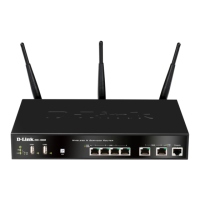D-Link DSR-Series User Manual 44
Section 5 - Connect to the Internet
Load Balancing
Path: Network > Internet > WAN Mode
This feature allows you to use multiple WAN links (and presumably multiple ISP’s) simultaneously. After
conguring more than one WAN port, the load balancing option is available to carry trac over more than one
link. Protocol bindings are used to segregate and assign services over one WAN port in order to manage internet
ow. The congured failure detection method is used at regular intervals on all congured WAN ports when in
Load Balancing mode.
This router currently supports three algorithms for Load Balancing:
Round Robin: This algorithm is particularly useful when the connection speed of one WAN port greatly
diers from another. In this case you can dene protocol bindings to route low-latency services (such
as VOIP) over the higher -speed link and let low-volume background trac (such as SMTP) go over the
lower speed link. Protocol binding is explained in next section.
Spillover: If Spillover method is selected, the primary WAN acts as a dedicated link until a dened
bandwidth threshold are reached. After this, the secondary WAN will be used for new connections.
Inbound connections on the secondary WAN are permitted with this mode, as the spillover logic governs
outbound connections moving from the primary to secondary WAN. You can congure spillover mode
by using following options:
• Load Tolerance: It is the percentage of bandwidth after which the router switches to
secondary WAN.
• Max Bandwidth: This sets the maximum bandwidth tolerable by the primary WAN for
outbound trac.
If the link bandwidth of outbound trac goes above the load tolerance value of max bandwidth, the
router will spillover the next connections to secondary WAN.
For example, if the maximum bandwidth of primary WAN is 1Kbps and the load tolerance is set to 70. Now
every time a new connection is established the bandwidth increases. After a certain number of connections say
bandwidth reached 70% of 1Kbps, the new outbound connections will be spilled over to secondary WAN. The
maximum value of load tolerance is 80% and the minimum is 20%.
Note: The DSR-1000, DSR-1000N, DSR-500, and DSR-500N routers support the trac load balancing between physical
WAN port and a 3G USB Modem.
Load balancing is particularly useful when the connection speed of one WAN port greatly diers from another.
In this case you can dene protocol bindings to route low-latency services (such as VOIP) over the higher-speed
link and let low-volume background trac (such as SMTP) go over the lower speed link.

